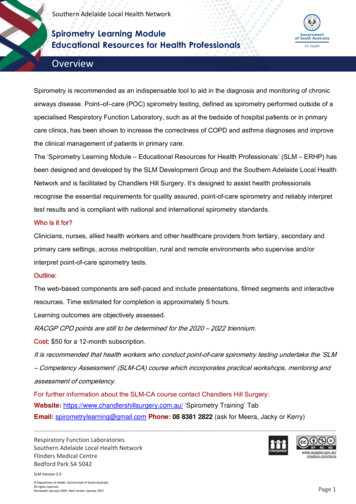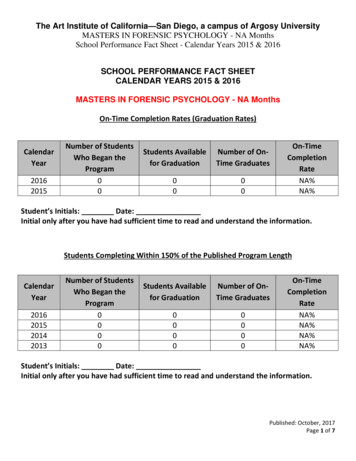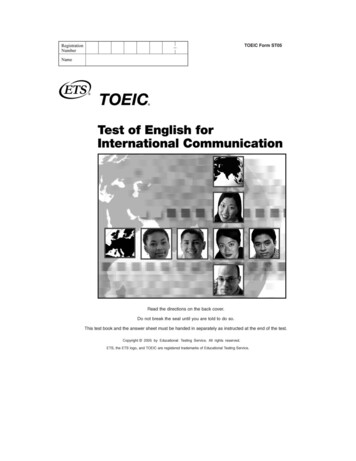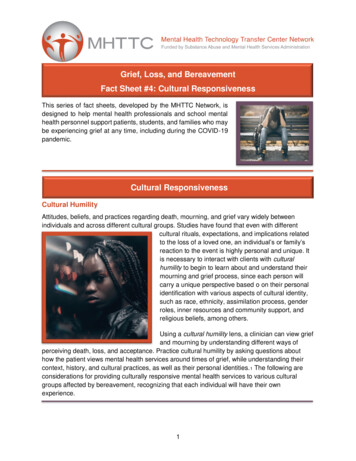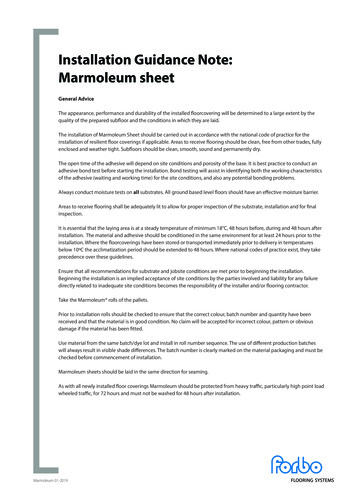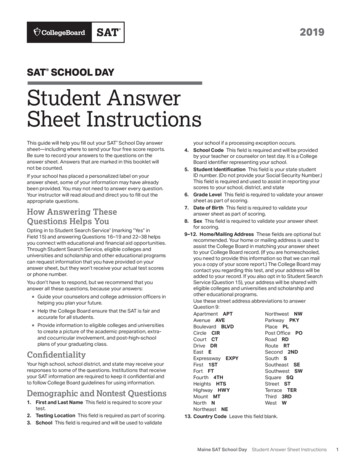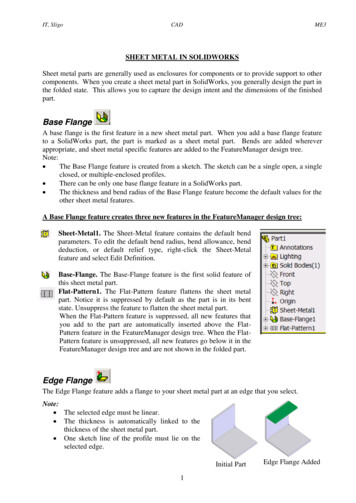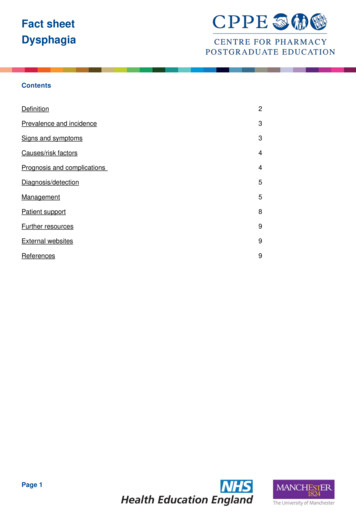
Transcription
Fact sheetDysphagiaContentsDefinition2Prevalence and incidence3Signs and symptoms3Causes/risk factors4Prognosis and nt support8Further resources9External websites9References9Page 1
Fact sheetDysphagiaDefinitionThe Royal College of Speech and Language Therapists (RCSLT)’s definition states that ‘Dysphagia is theterm used to describe a swallowing disorder usually resulting from a neurological or physical impairment ofthe oral, pharyngeal or oesophageal mechanisms.’The diagram below illustrates what occurs during a swallow, with and without dysphagia.The swallow process can be described in four stages:1. oral preparatory– saliva is produced, food is prepared in the mouth by chewing and/or movement,and a food bolus (ball of food) is formed2. oral – the tongue moves the food bolus to the back of the mouth3. oropharyngeal – the tongue pushes the food bolus through the throat to the oesophagus; theepiglottis covers the larynx at this point to prevent the food bolus from entering the trachea4. oesophageal – the muscles of the oesophagus push the food bolus through to the stomach in aprocess called peristalsis.8(The process can be described in three stages; in this case, 2 and 3 are grouped together.)The first three stages are called the oropharyngeal phase; dysfunction during this phase leads tooropharyngeal dysphagia. The last stage is called the oesophageal phase; dysfunction during this phaseleads to oesophageal dysphagia1. For a normal swallow to take place, there needs to be synchronisation ofPage 2
Fact sheetDysphagiathe respiratory, oral, pharyngeal, laryngeal and oesophageal anatomical structures. This synchronisationdepends on the motor and sensory nervous system being intact.Dysphagia can be acute or chronic. Acute dysphagia may be a result of an exacerbation ofgastroesophageal reflux disease, while chronic dysphagia may be a result of a stroke or Parkinson’sdisease, for example.2To view animations of a normal swallow and a dysphagic swallow, watch the following video, Guide todysphagia – 3D animations of swallowing.Return to contentsPrevalence and incidenceAccording to the RCSLT, ‘research has found the following rates of prevalence and incidence: Between 50-75 percent of nursing home residents Between 50-60 percent of head and neck cancer survivors Between 40-78 percent of stroke survivors – of those with initial dysphagia following stroke, 76% willremain with a moderate to severe dysphagia and 15 percent with profound dysphagia In 48 percent of patients undergoing cervical discectomy and fusion In 33 percent of the people with multiple sclerosis In 27 percent of those with chronic obstructive pulmonary disease In 10 percent of acutely hospitalised older people In 5 percent of adults with a learning disability, 5 percent of community-based individuals withlearning disabilities and 36 percent of hospital-based individuals.’3Return to contentsSigns and symptomsThe main symptom of dysphagia is difficulty or inability to swallow. Other symptoms include: coughing or choking when eating or drinking recurrent chest infections gasping for breath when eating and/or drinkingo regurgitationo a sensation that food is stuck in throat or chesto droolingPage 3
Fact sheetDysphagia o inability to chew food properlya 'gurgly' wet sounding voice when eating or drinking.4Return to contentsCauses/risk factorsDysphagia may be due to: structural impairment, eg, pharyngeal pouch, cleft palate, or a cancer of the tongue or larynx developmental impairment, eg, learning disability or cerebral palsy neurological disorders, eg, stroke, multiple sclerosis, Parkinson’s disease, motor neuronedisease, dementia, muscular dystrophy or traumatic brain injury respiratory disease, eg, chronic obstructive pulmonary disease (COPD), emphysema or asthma gastroesophageal reflux disease.3,5The risk of dysphagia also depends on factors such as: a person’s position and strength posture the size and texture of the food bolus (thickened fluids and soft foods are easier to swallow) disuse of swallow due to illness aging (which can reduce saliva production and weaken muscles)3 cognition respiratory and cardiac problems.Return to contentsPrognosis and complicationsIn people with neurological conditions, oropharyngeal dysphagia is associated with poorer outcomesincluding pneumonia and increased mortality. Dysphagia can also lead to an increased anxiety and fear ofeating, leading to malnutrition, dehydration, depression and isolation4,6. Dysphagia can also lead toproblems with medicine administration.Aspiration pneumonia is a serious problem which is associated with dysphagia. 40 percent of people withlearning disabilities and dysphagia experience recurrent respiratory tract infections, and aspirationpneumonia is reported to be a significant cause of death7. Over 50 percent of those with advanceddementia develop pneumonia and pneumonia causes 30 percent of post-stroke deaths8.In the following National Foundation of Swallowing Disorders video, we meet several people affected bydysphagia and learn about how it impacts on their lives.National Foundation of Swallowing Disorders - Swallow: a documentary - dysphagiaWarning: this video contains some strong language.Page 4
Fact sheetDysphagiaReturn to contentsDiagnosis/detectionDiagnosis of dysphagia may be made based on a clinical history, and after tests such as a swallow test,endoscopy, barium videofluoroscopy (also known as the modified barium swallow) and other imaging tests.Indicators of dysphagia are described by National Institute for Health and Care Excellence (NICE) in clinicalguideline Nutrition support for adults: oral nutrition support, enteral tube feeding and parenteralnutrition [CG32].More information about the tests used to diagnose dysphagia can be found on the NHS page Dysphagia(swallowing problems) – Diagnosis.Diagnosis and assessment of dysphagia also involves determining the underlying cause and ruling outdifferential diagnoses. Speech and language therapists (SLTs), neurologists and gastroenterologists maybe involved in this process9.Return to contentsManagementThe management of dysphagia depends on the underlying cause and type of dysphagia.In oropharyngeal dysphagia, the improvement of the way that food and drink is moved to prevent aspirationand other complications is highly important6.Management options include: swallowing rehabilitation and re-education nutrition and dietary modification, including food texture and fluid consistency modification the use of feeding tubes6 surgical treatments1 transcutaneous neuro-muscular electrical stimulation (NMES).Swallowing rehabilitation and re-educationThis is offered by swallow specialists such as SLTs. It may involve changing a person’s posture andencouraging changes in their behaviour. Strengthening exercises may also be offered.6Page 5
Fact sheetDysphagiaNutrition and dietary modificationsAltering food texture and consistency can aid swallowing.1Change in terminologyBefore discussing the manipulation of food and medicines, we should consider a recent change interminology. Due to issues with standardisation of terminology used to describe food texture, theInternational Dysphagia Diet Standardisation Initiative (IDDSI) has produced the framework shown below.Credit: The International Dysphagia Diet Standardisation Initiative. 2016.This framework introduces standard terminology to describe texture modification for food and drink10. Moreinformation can be found in the Complete IDDSI framework: Detailed definitions document.NHS Improvement’s patient safety alert, Resources to support safer modification of food and drink,requires all NHS organisations to transition from using the term ‘soft diet’ to the terminology in the IDDSIframework to reduce patient safety incidents.11A previous patient safety alert, Stage One: Warning – Risk of death from asphyxiation by accidentalingestion of fluid/food thickening powder, was issued to raise awareness of the need for proper storagePage 6
Fact sheetDysphagiaand management of thickening powder used as part of the treatment for people with dysphagia. This wasdue to reports of harm due to accidental swallowing of the powder.Manipulation of dietIt should be noted that the resources in the remainder of this section use the previous dysphagia diet foodtexture descriptors that were in use prior to the introduction of the IDDSI framework.The PrescQIPP bulletin, Care homes - assisting people with swallowing difficulties, looks at treatmentstrategies for adults with swallowing difficulties, including people in both care homes and domiciliary caresettings. It includes dietary modification by prescribing thickeners, and other options such as environmentalmodifications, safe swallowing advice, and the application of swallowing strategies.Managing medicines in dysphagiaAltering texture and consistency can also aid swallowing of medicines.Manipulation of medicinesNot all tablets and capsules are suitable for dispersing, crushing or opening for administration in soft foodor via a feeding tube. The following Pharmaceutical Journal (PJ) article, by Barnett and Parmar, exploreshow to manage medicines for people with dysphagia. It covers alternative formulations and manipulatingsolid dosage forms: How to tailor medication formulations for patients with dysphagia.As discussed in the PJ article, crushing tablets or opening capsules makes a medicine unlicensed. The useof medicines in this way has legal and professional implications for not only the prescriber, but also thesupplier of the medicine and person who administers it. More information can be found on the SpecialistPharmacy Service (SPS) website.Thickening agentsThere are two types of thickeners; starch based and gum based.Macragol laxatives (polyethylene glycol laxatives) must not be mixed together with starch based thickenersas they can oppose the thickening action, resulting in a thin liquid putting the patient at increased risk ofaspiration.More information can be found on the SPS website ened-fluids-do-they-interact-with-medicines/ and the MHRA alert sed-risk-of-aspiration.Information sourcesThe Healthcare professionals section of the Swallowing Difficulties website provides prescribinginformation, guidelines, and advice on formulation and administration.There are two resources that are widely used when considering the administration of medicines for thosewith swallowing difficulties or via enteral feeding tubes. These resources require subscriptions, which yourorganisation may hold: Handbook of drug administration via enteral feeding tubes via MedicinesComplete.Page 7
Fact sheetDysphagia The NEWT guidelines for administration of medicines to patients with enteral feeding tubes orswallowing difficulties.Care homesCare home staff may only administer medicines in an unlicensed manner on the instructions of theprescriber. This means that a written direction to crush or disperse tablets, or open capsules, must bedocumented on the person’s prescription and in their care plan1.The SPS hosts UK Medicines Information (UKMi) guidance relating to the manipulation of solid dosageforms in care homes and managing medicines for those who are unable to take solid dosage forms: What are the therapeutic options for patients unable to take solid oral dosage forms? What are the considerations when crushing tablets or opening capsules in a care homesetting?It should be noted that covert administration, where medicines are concealed in food or drink, is a morecomplex issue. For more information about covert administration, access the following PJ article by KellyFatemi, Covert administration of medicines in care homes.Enteral feeding tubesFeeding tubes may be offered in more severe cases of dysphagia. They may be used short term whilesomeone’s ability to swallow recovers, or more long term if this is required.The most common types of enteral feeding tubes are: Nasogastric (NG) tubes and nasojejunal (NJ) tubes are passed through the nose into the stomach(NG), or jejunum (NJ), and are designed for more short-term use, usually being replaced monthly. Percutaneous endoscopic gastrostomy (PEG) or percutaneous endoscopic jejunostomy (PEJ) tubesare passed through the skin directly into the stomach and are replaced less frequently than NG/NJtubes.The Patient.info article, Enteral feeding, for medical professionals contains more information about enteralfeeding tubes.When nutrition is delivered via enteral feeding tubes, close monitoring of the person receiving this nutritionis required. The British Association for Parenteral and Enteral Nutrition’s (BAPEN) Enteral feedmonitoring offers recommendations for monitoring that should be undertaken.Medicine administration via enteral feeding tubesBoth feeds and medicines may be administered by enteral feeding tubes. Tube diameter, material size andthe administration of feeds need to be considered when making recommendations on the administration ofmedicines via enteral feeding tubes. The SPS document prepared by UKMi (How do the different typesof enteral feeding tubes available affect drug administration?) is a quick reference summary todifferent types of enteral feeding tubes for medicine issues.The resources outlined above under Managing medicines in dysphagia are useful when making decisionsabout administration of medicines via enteral feeding tubes.Page 8
Fact sheetDysphagiaBAPEN also offers a practical guide to Administering drugs via enteral feeding tubes, which can beused when offering advice on administration of medicines via enteral feeding tubes.Return to contentsPatient supportThere are support organisations for people who suffer from the underlying cause of dysphagia: Parkinson’s UK Stroke Association MS Society Huntington’s Disease Association Age UK Cancer Research UK Macmillan Cancer SupportThe NHS offers a Dysphagia (swallowing problems) page, which covers causes, diagnosis andtreatment.Return to contentsFurther resourcesThe following guidelines contain further information which can support the management of those withdysphagia: NICE clinical guideline, Stroke and transient ischaemic attack in over 16s: diagnosis and initialmanagement [NG128] NICE clinical guideline, Stroke rehabilitation in adults [CG162] Scottish Intercollegiate Guidelines Network (SIGN) clinical guideline 119, Management of patientswith stroke: identification and management of dysphagia The patients association, Care Home Charter for Swallowing and Medicines Specialist Pharmacy Service, How can medicines be managed for Parkinson’s patients withswallowing difficulties? Herts Valley CCG, ‘Special’s alternative guide’ Leeds Medicine Advice Service, Administering medicines for patients who have thickenedfluids - pragmatic advice Specialist Pharmacy Service, Thickening agents and thickened fluids: do they interact withmedicines? Medicines and Healthcare products Regulatory Agency. Drug Safety Update April 2021;14(9)Return to contentsWebinarsThe following webinars contain further information that can support the management of those withdysphagia:Page 9
Fact sheetDysphagia Specialist Pharmacy Service, MUS webinar, Improving patient safety in dysphagia throughmedicines optimisationE-learningTo further support your knowledge and understanding of the management of dysphagia, complete the elearning ide/External websitesCPPE is not responsible for the content of any non-CPPE websites mentioned on this page or for theaccuracy of any information to be found there.All web links were accessed on 4 August 2021Return to contentsReferences1. NHS. Dysphagia (swallowing problems). Treatment. 2018.2. Wright D and Tomlin S. How to help if a patient can’t swallow. Pharmaceutical Journal.2011:286;5.3. Royal College of Speech and Language Therapists/Giving Voice. Giving voice to people withswallowing difficulties. No date.4. NHS. Dysphagia (swallowing problems). Overview. 2018.5. NHS. Dysphagia (swallowing problems). Causes. 2018.6. World Gastroenterology Organisation. Global guidelines – Dysphagia. 2014.7. Public Health England. Dysphagia in people with learning difficulties: reasonable adjustmentsguidance. 2016.8. Barnett N and Parmar P. How to tailor medication formulations for patients with dysphagia.Pharmaceutical Journal. 2016:297;7892.9. NHS. Dysphagia (swallowing problems). Diagnosis. 2018.10. International Dysphagia Diet Standardisation Initiative. Complete IDDSI framework: Detaileddefinitions. 2017.11. NHS Improvement. Patient safety alert: Resources to support safer modification of food anddrink. 2018.12. UK Medicines Information. Medicines Q&As – What are the therapeutic options for patientsunable to take solid oral dosage forms? 2013.Return to contentsLast review: August 2021Next review due: February 2022Page 10
Diagnosis and assessment of dysphagia also involves determining the underlying cause and ruling out differential diagnoses. Speech and language therapists (SLTs), neurologist

